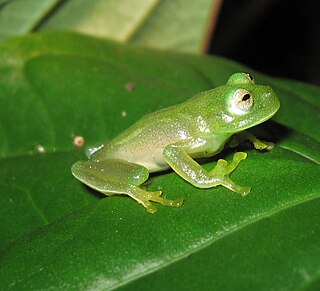
The glass frogs belong to the amphibian family Centrolenidae. While the general background coloration of most glass frogs is primarily lime green, the abdominal skin of some members of this family is transparent and translucent, giving the glass frog its common name. The internal viscera, including the heart, liver, and gastrointestinal tract, are visible through the skin. When active their blood makes them visible; when sleeping most of the blood is concealed in the liver, hiding them. Glass frogs are arboreal, living mainly in trees, and only come out for mating season. Their transparency conceals them very effectively when sleeping on a green leaf, as they habitually do.

Cochranella is a genus of glass frogs, family Centrolenidae. They are found in Central America from Honduras southward to the Amazonian and Andean cloud forests of Colombia, Ecuador, Peru, and Bolivia.

Hyalinobatrachium is a genus of glass frogs, family Centrolenidae. They are widely distributed in the Americas, from tropical Mexico to southeastern Brazil and Argentina.
"Centrolene" medemi is a species of frog in the family Centrolenidae. The species occurs in the Cordillera Oriental in the Tolima, Caquetá, and Putumayo Departments in Colombia and adjacent Napo in Ecuador. The generic placement of this species within the subfamily Centroleninae is uncertain. The specific name medemi honors Fred Medem, collector of the holotype. Common name Medem giant glass frog has been coined for it.
Centrolene notosticta is a species of frog in the family Centrolenidae. It is found on the Cordillera Oriental in Colombia and on its extension to north, Serranía del Perijá, in the Zulia state in Venezuela.
"Cochranella" duidaeana, commonly known as the Duida Cochran frog, is a species of frog in the family Centrolenidae. It is endemic to Cerro Duida, Venezuela. The generic placement of this species within the subfamily Centroleninae is uncertain.

Vitreorana ritae is a species of frog in the glass frog family (Centrolenidae). It is found in Amazonian Brazil, Colombia, Ecuador, and Peru, and in southern Guyana, eastern Suriname, and French Guiana. Its natural habitats are tropical moist lowland forests and rivers. It is threatened by habitat loss.
"Cochranella" riveroi is a species of frog in the family Centrolenidae. It is endemic to Cerro Aracamuni, Venezuela. The generic placement of this species within the subfamily Centroleninae is uncertain.
"Cochranella" xanthocheridia is a species of frog in the family Centrolenidae. It has an uncertain generic placement within subfamily Centroleninae; molecular data are not available and morphological and behavioural characters do not unambiguously place it in any specific genus.

Nymphargus is a genus of glass frogs in the subfamily Centroleninae, which was established in 2007. They are distributed in the Andean slopes of Colombia, Ecuador, Peru, and Bolivia. They are characterized by lacking webbing among the outer fingers, lacking humeral spines in adult males, and having a lobed liver covered by a transparent hepatic peritoneum. They can be more specifically characterized as having a head that is darker green than the body, there being yellow spots surrounded by black on head and body, upper eyelids are dark lavender. The conservation status of the Nymphargus frogs was largely believed to be critically endangered due to the minimal research done on this genus. Once the scope of the research was broadened the conservation status was able to be determined as being vulnerable. More frogs of different variations were found increasing the genus’ population.

Centroleninae is one of two subfamilies of the family Centrolenidae. It has nine genera distributed in Central America from Honduras south and east to northern and central South America. As of mid 2015, it contains 117 species.

Vitreorana is a genus of glass frogs that are native to South America, from the Atlantic Forest of Brazil and Argentina to the Amazon rainforest of Colombia and Ecuador and to the Venezuelan Coastal Range and the Guianas. One way one can tell this type of glass frog from others is through their green bones, lavender-colored dorsal, and white highlighted pigment. This genus has also started to become endangered, especially in Brazil, where many Vitreorana, such as V. eurygnatha due to habitat loss.

Hyalinobatrachinae is a subfamily of glass frogs that was established in 2009. They are found in the Americas from Mexico south to southeastern Brazil and Argentina.
Celsiella is a small genus of glass frogs endemic to Venezuela. It was established in 2009 and named in honour of Josefa Celsa Señaris, nicknamed "Celsi", a Venezuelan herpetologist who had worked with glass frogs.

Josefa Celsa Señaris is a Venezuelan herpetologist. She has published information about frogs and she has identified new genera and species. Señaris is the director of the La Salle Foundation's Natural History Museum in Caracas.

Chimerella is a small genus of glass frogs, family Centrolenidae. They are found on the Amazonian slopes of the Andes in Ecuador and Peru, possibly extending into Colombia.

Sachatamia is a small genus of glass frogs. They are found in Central America and northern South America at altitudes below 1,500 m (4,900 ft) above sea level.

Rulyrana is a small genus of glass frogs. They are found in South America, on the Amazonian slopes of the Andes in Ecuador, Peru, and possibly Bolivia, as well as on the eastern slopes of the Cordillera Central and the western slopes of the Cordillera Oriental in Colombia.
Juan Manuel Guayasamin is an Ecuadorian biologist. He earned his Ph.D. in 2007 from University of Kansas, Department of Ecology and Evolutionary Biology and as of 2017 he is working as professor at Universidad San Francisco de Quito in Ecuador. His research interests include the evolution of glass frogs (Centrolenidae) and direct-developing anurans. His main contributions have been: phylogenetic taxonomy of glassfrogs, description of the variation of skin texture in frogs, description of numerous species of amphibians and reptiles, and a monographic review of all Ecuadorian glassfrogs. A team led by Juan M. Guayasamin discovered Hyalinobatrachium yaku in May 2017, a glassfrog with transparent venter. To date (2020), he has described a total of 6 amphibian genera, 55 species of amphibians, and 11 reptiles, including two geckos from the Galápagos Islands.

Ikakogi is a genus of frogs in the family Centrolenidae. It has been tentatively placed in the subfamily Centroleninae, although more recent analyses suggest that it is the sister group of the clade Centroleninae+Hyalinobatrachiinae.












